Cement mixers have been used by artists in larger sculpting pieces for quite some time. The use of a cement mixer in art is nothing new. Why do artists turn to these powerful machines in modern times? Mixers are a practical method of creating concrete sculptures that are durable, especially to the elements. These machines are originally designed for construction purposes, but have become popular in sculptural art due to their consistent mixing abilities and space for creative flexibility.
Mixers are known for mixing uniform batches of concrete, contributing to its strength. Artists make use of this factor to add quality to their artistic creations. Weather artists use them for small lawn ornament creation or large public installations; the machinery simplifies the mixing process, saving time and energy. In this article, we will explore the use of ordinary mixers in the art world and discuss how the integration of mixers contributes to durable artwork.
Core Sculptural Techniques
Artists have long been creating larger masterpieces, designed to inspire, usually installed in monumental-sized spaces. Classical masters like Michelangelo, Donatello and Bernini come to mind. However, these classical sculpting masters took years and sometimes decades to complete their artworks due to the limited technology available to them in the 15th and 16th centuries. Could you imagine what they would create today with a little help from a powerful Honda GP160 5.5 HP engine? Well, modern artists can and are making use of these machines to mix ingredients such as cement, gravel, aggregates and sand. They can now blend these materials with ease, in short periods of time, and yield reliable materials to pour and sculpt.
Casting With A Cement Mixer
Casting remains a fundamental sculptural technique, easily facilitated by cement mixers. Artists pour wet concrete from the mixer into moulds shaped from materials like latex, wood, or metal. The moulds allow the creation of precise, reproducible forms from simple or complex designs. After curing, the mould is removed, revealing the sculpture’s shape. Artists may use multiple layers of concrete in various pours to add depth or detail. The mixer’s capacity to produce homogenous concrete expedites this process, reducing inconsistencies typical of manual mixing.
Wire Mesh Armature Technique
For more extensive or freeform sculptures, artists build armatures using wire mesh or metal frameworks. The armature acts as a skeleton, creating support and shape to the concrete layer. Artists can mix concrete in a cement mixer, and then apply it over the armature by pouring or towelling. This method can yield lightweight but strong sculptures that are adaptable to intricate or large-scale designs. The ease of producing large volumes of concrete at a time helps artists maintain consistent application.
Carving Concrete Sculptures
Carving is a style of sculpting which involves an artist sculpting a block of concrete after it has cured. Similar techniques and tools are used to sculpt, such as chisels and rasps, which refine surfaces and add interesting textures. Mixers save artists time by creating large batches of cement, which is used to cast blocks or forms that are suitable for carving. Artists have a limited window to carve, since concrete or cement hardens quickly, which is why consistent batches of mixed material are useful.
Material Innovation and Experimentation
Today’s contemporary artists enjoy experimenting with concrete mixers and creative materials. Some artists mix additives or recycled materials with their concrete to create eco-conscious art pieces. Artists can adjust the aggregates and pigments they use in their mixes to create artistic finishes, from smooth, polished surfaces to natural texture styles. Mixers’ ability to repeatedly produce materials, ready for use, allows for endless expression when creating artworks.

Colour And Texture Variations
The large quantities of materials being produced are not the only beneficial factor. When it comes to colour and texture, artists can modify their mix by adding different pigments directly to the cement mixer during the blending process. The uniformity of the mixer creates a consistent colour throughout the sculpture and eliminates any patchiness, which easily occurs during surface painting. Artists can also alternate aggregate sizes; they can include natural or organic materials, which produce innovative textures that resemble stone. By using concrete mixers, artists can prepare these creative mixtures repeatedly and with accuracy, creating fluency throughout the sculpture.
Recycled Materials And Sustainability
Another very popular technique among modern sculptors is to add recycled materials to their cement mixtures. The mixers simplify the blending of conventional cement with recycled glass or plastics. Using industrial by-products reduces waste, environmental impact and aligns with the eco-conscious movement in the art industry. Artists can now create large environmental sculptures with a reduced carbon footprint.
Surface Treatments
After sculpting, artists usually apply surface treatments to the cement or concrete. This is a technique used to enhance the appearance and durability of their concrete works, similar to glazing pottery. It adds aesthetic appeal and protects the surface from elements. Outdoor sculptures need specific materials to survive weather conditions like rain and sun exposure. Sudden changes in temperature can cause cracks and affect the integrity of the piece, which can be dangerous when large and in public spaces.

Artists In Practice
Public and large-scale sculptures take less time to produce, since artists have ready-to-use mixed materials for continuous pouring and layering. The uniformity of the mix contributes to the strength and durability of the piece, keeping it from corroding when exposed to the elements. The speed at which materials are mixed helps artists to stay on track with timelines, transforming ambitious artistic concepts into strong, lasting sculptures.
Artist Spotlight: Jane Collins On Using Mixers In Sculpture
Jane Collins, an acclaimed concrete sculptor, shares her experience with concrete mixers in creating complex works. She mentions how the mixer’s efficiency allows her to experiment with large volumes of materials without compromising quality. According to Collins, consistency in the mix is incredibly important to achieving the precise texture and strength her sculptures require. The mixer also helps reduce mixing time, which is needed for managing the curing process effectively. Her projects often involve layering concrete over wire armatures, and she credits mixers with expanding her creative possibilities.
Traditional Methods And Modern Tools
Artists like Jane Collins use classic hand-sculpting techniques but incorporate a cement mixer as a tool. She blends concrete in the mixer and then applies it by hand to build texture and depth. Her technique helps her to stay in control while using the machine’s power and volume capabilities. Collins stresses that mixers are not a substitute for craftsmanship but serve as a valuable tool in the creative process. She mentions that mixers enable greater scale and precision.
While Collins praises the benefits, she acknowledges challenges in using concrete mixers for art. Managing the timing of concrete hydration requires careful planning, as premature setting can affect the work. She emphasises cleaning the mixer thoroughly to prevent material contamination, which could alter the sculpture’s finish or strength. Through experience, she has developed routines to optimise mixer use unique to artistic applications, blending practical knowledge with creative insight.
Artist Michael Reed’s Approach To Concrete Sculpture
Michael Reed, a contemporary sculptor known for his textured concrete pieces, explains how cement mixers are fundamental to his workflow. Reed appreciates the machine’s ability to mix batches with precision, batches that suit the varying demands of his abstract projects. He often makes use of unusual aggregates such as crushed shells or coloured glass to add visual interest. The cement mixer allows him to maintain consistency across his pieces, an important element when producing a series of sculptures with related themes.
According to Reed, mixers free up some of his time. Instead of long hours of manual mixing, he can focus on form and detail. He enjoys experimenting with his mixtures, layering to create dimensions and depth. His work has texture and allows viewers to visually and textually engage with his artwork. His experience mentions how technological tools complement artistic creativity without replacing the tactile and intuitive nature of sculpture.
Education, Community, And the Future
Concrete mixers have found a place in art education settings as well. Students can learn sculptural techniques by using concrete. The equipment used teaches fundamentals in mixing and casting, with hands-on experience with a practical tool. Educators appreciate that concrete mixers provide uniform mixes, allowing students to focus on their creative design rather than struggling with manual preparation.
Concrete Sculpture And Public Engagement
Sculptures which are created using concrete mixers and placed in parks, elevate environments and invite interaction from the community. This enriches cultural experiences and improves tourism. Artworks remain stable over time due to the consistency of the concrete mixture. Artists who design sculptures for public areas make use of mixers; they rely on mixers to create quality works.
Cement Mixers With Digital Technology
Modern sculptors make use of digital technologies like 3D printing or CNC milling in artworks. These methods are used in combination with tools such as mixers. Today’s methods might be far off from those of the 16th-century artist, but the innovation and creative control are the same. Their methods help them to design complex components digitally, which are then realised physically using concrete mixed in cement mixers. They are able to achieve new avenues while enhancing their precision.
Future Perspectives On Cement Mixing In Art
What does the future of cement mixers in artistic sculpture look like? Well, the future looks promising as materials are becoming more affordable and machinery is becoming more durable. The developments in lightweight and ultra-durable concrete formulas, used with evolved machinery, will broaden artistic capabilities and expression. The innovation in mixer designs may allow for more control in future, perhaps including features like temperature controls.

BS Power’s Range Of Mixers: Ideal For The Modern Sculptor
Modern mixers allow artists to create balanced works of art which are not only durable to environmental elements but strong enough to last decades, perhaps even centuries. The action of casting and carving concrete makes the material ideal for artistic use. The elimination of hard, manual labour, which is time-consuming, allows artists to focus on the details that set them apart from others. They are able to incorporate additives and pigments, making mixing truly experimental and unique.
For artists committed to concrete as a form, mixers offer amazing support, allowing the realisation of sculptural masterpieces that engage and endure. BS Power offers a range of cement mixers, suitable for different volume requirements. These machines are ideal for artists who require durable and dependable machinery for their creations. For more information on our cement and concrete mixer range, visit our website.






